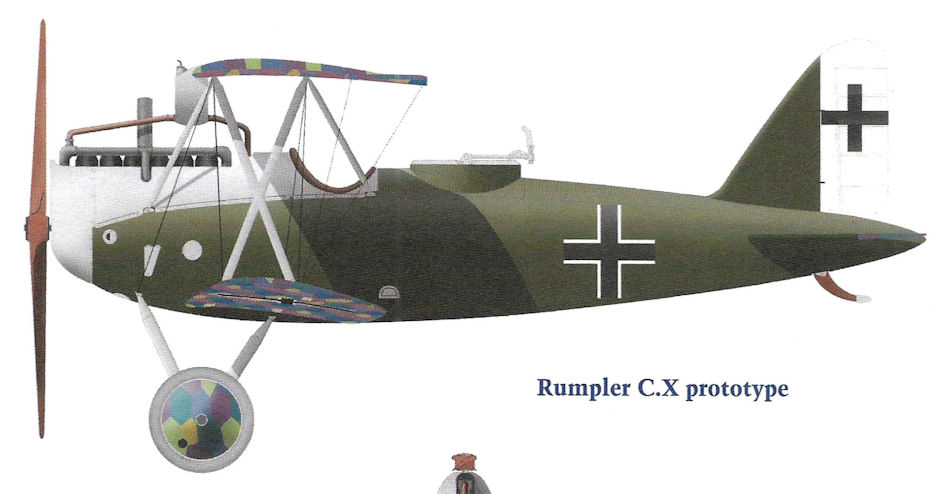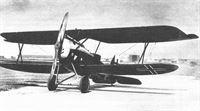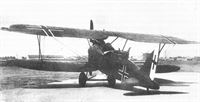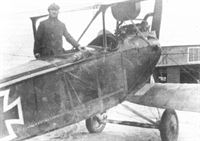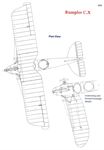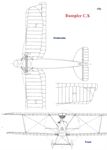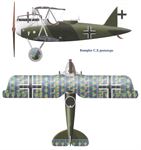O.Thetford, P.Gray German Aircraft of the First World War (Putnam)
Rumpler C X (8C 14)
This progressive two-seater of 1918 featured the usual Rumpler wing profile, but with single bay "X" struts, which obviated the necessity for incidence bracing. Only a single aircraft was built, and when this was extensively damaged in a collision on the ground the type was not proceeded with. Engine, 240 h.p. Maybach Mb IV. Span, 10.5 m. (34 ft. 5 1/2 in.). Length, 6.9 m. (22 ft. 7 3/4 in.). Height, 3.12 m. (10 ft. 3 1/4 in.). Area, 29 sq.m. (313 sq.ft.). Weights: Empty, 950 kg. (2,090 lb.). Loaded, 1,385 kg. (3,047 lb.). Speed, 195 km.hr. (121.875 m.p.h.). Climb, 6,000 m. (19,680 ft.) in 27 min. Duration, 3 1/2 hr. Armament, one Spandau and one Parabellum machine-guns.
J.Herris Rumpler Aircraft of WWI (A Centennial Perspective on Great War Airplanes 11)
Rumpler C.X
The Rumpler C.X was the last production type in a long line of successful Rumpler two-seaters. The Rumpler C.I, powered by the 160 hp Mercedes D.III engine and its contemporaries, entered service in 1915 and was an immediate success. It was kept in production for the remainder of the war, initially as a combat aircraft, later as a trainer. The C.III, powered by the 200 hp Benz Bz.IV engine, entered service in 1916, only to be quickly superceded by the even more powerful and successful C.IV.
Rumpler continued development of C-type aircraft throughout the war. While more radical designs like the 7C1 were explored, all production aircraft evolved from earlier designs and all later operational types used the basic C.IV airframe. At the beginning of 1918, Rumpler tested the prototype 8C12, with 260 hp Daimler D.IVa engine and the wing cellule of the C.IV, but with two 'U'-profile interplane struts. Upon test flying the 8C12, it was determined that it had an unsatisfactory climb performance. Test pilot Friedrich Budig was surprised at these results as, when compared to the experimental 6A7 aircraft (prototype C.IV), the 8C12 prototype had been computed as having an additional 57 kg of propeller thrust. Due to the reduced drag it was calculated that the required climb should have been possible with 230 hp.
Since the propeller efficiency was obviously not reduced, Budig decided to introduce measures to make the aircraft more aerodynamic. Like the prototype C.I, he decided to change the angle of attack of the wings. The result was that the aircraft's climbing performance improved by about one minute.
The prototype 8C13 received likewise the 260 hp Daimler D.IVa engine, but used the wing cellule of the C.VII. From this aircraft the prototype 8C14 was developed in early 1918 that became the series version of the Rumpler C.X. Its 260 hp Maybach Mb.IVa engine was completely enclosed in an aluminum cowling. The compact, almost oval fuselage was only 6.9 meters long and well streamlined. The wings were staggered and connected by 'X' struts, which tilted outward at the top. The wing spars, manufactured from pine, had a double 'T' cross-section. In contrast to the lower wing, the upper wing had neither sweep nor dihedral, and had a span of 10.50 meters and balanced ailerons. The lower wing span was 9.00 meters. The cantilever tail unit had a short, straight dorsal fin, which was built as an integral part of the fuselage. The rudder was relatively narrow and had a right-angled vertical trailing edge. The horizontal tail unit had the proven negative airfoil curvature.
In the summer of 1918 the C.X prototype was damaged in a crash landing. Despite this setback, the test program was not affected. With an empty weight of 950 kg the aircraft was lighter than the earlier C.IV. The smaller wing and single-bay bracing were responsible for much of the weight saving and also reduced drag. With the over-compressed 260 hp Maybach engine coupled with a lighter, more aerodynamic airframe than the C.IV, the C.X had a maximum speed of 195 km/h and a service ceiling of 7,800 meters, which it could reach in 59 minutes. Thus the C.X was by far the highest flying and fastest German C-type aircraft of the war. "Based on this performance we now received an order," said Gustav Basser in August 1918. However, only a few examples were built and tested by the end of the war.
The Rumpler C.X had the performance to carry on the Rumpler tradition of being the leading German long-range reconnaissance aircraft, but the war ended before it could reach operations.
Rumpler C.X Specifications
Engine: 260 hp Maybach Mb.IVa
Wing: Span (Upper) 10.50 m
Span (lower) 9.00 m
Chord (Upper) 1.80 m
Chord (Lower, mid- wing) 1.40 m
Area 29.0 m1
General: Length 6.90 m
Empty Weight 957 kg
Useful Load 435 kg
Loaded Weight 1,385 kg
Maximum Speed: 195 kmh
Climb: 6000m 27.0 min
7800m 59.3 min
Service Ceiling: 7800m
Range: 585 km

